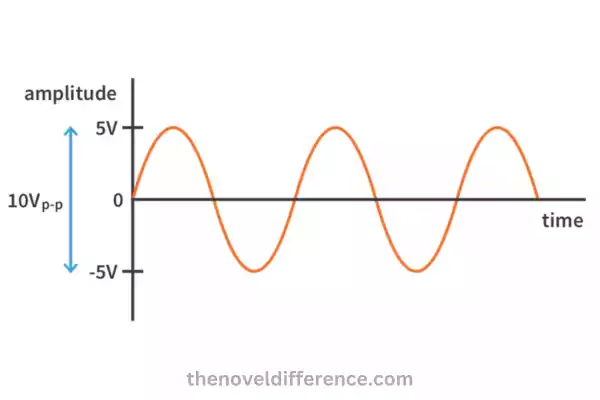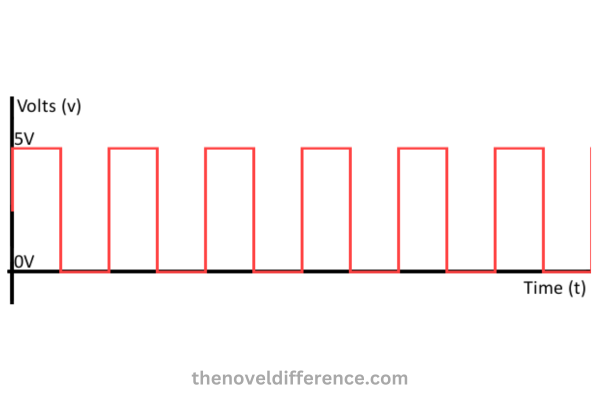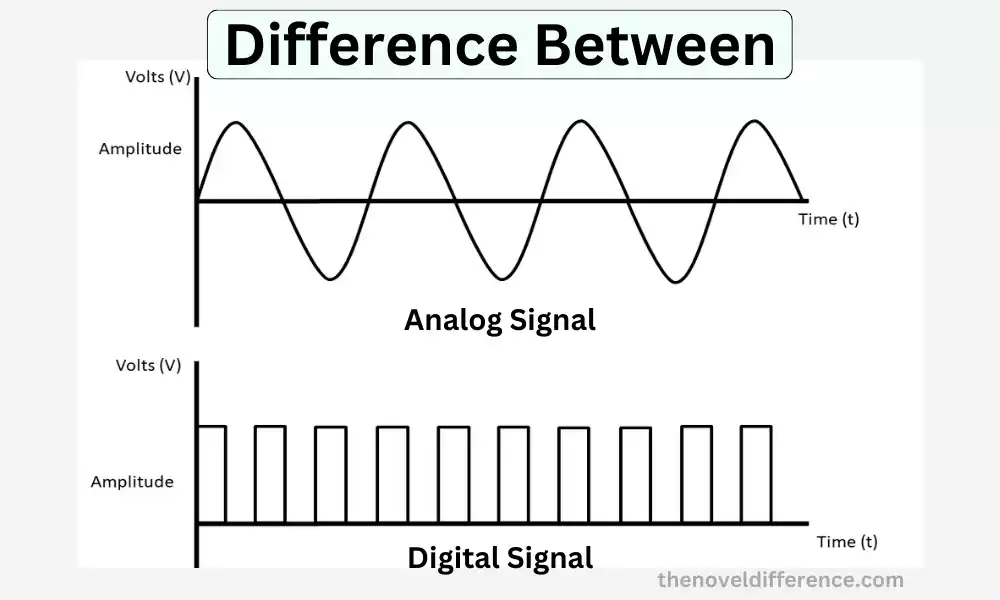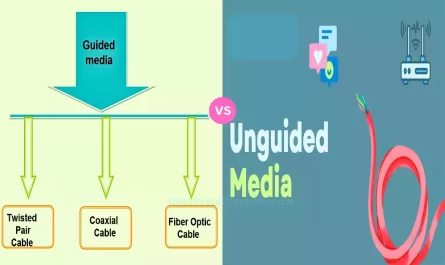Modern technologies rely heavily on transmitting and processing information; signals play an essential role here as information carriers. Analog and digital signals are two popular representations used widely across electronic systems – this article will look into their differences, characteristics, applications in various areas as well as any limitations they might present.
Definition of Analog Signal and Digital Signal
Analog signal:
An analog signal is a continuous electrical signal that represents information by varying its voltage or current smoothly and uninterruptedly over time. It represents a physical quantity that can take on any value within a given range.
An analog signal can often be defined as being “analogous” to its source data or phenomenon as they maintain an immediate correlation between it and what information it carries.
The amplitude, frequency, and phase continuously change in an analog signal to convey the desired information. Examples of analog signals include audio waves, voltage fluctuations, and analog telephony signals.
Digital signal:
Digital signals are discrete representations of data in binary form that contain discrete values or symbols that create discreteness in the presentation of information. Unlike analog signals, which are continuous, digital signals are characterized by distinct and separate values, typically represented as 0s and 1s.
Each discrete value in a digital signal is called a “bit” (short for binary digit). Digital signals are widely utilized to encode and transmit various data types such as texts, images, videos, and computer instructions.
Their discrete nature enables precise yet reliable transmission and storage as they are less prone to noise distortion than analog signals. Digital signals are encoded, processed, and transmitted with digital systems and devices like computers digital communication networks along with audio/video technology.
Importance of understanding the difference
Understanding the distinction between digital and analog signals is vital for many reasons:
Signal Processing: Digital and analog signals require different techniques of processing. Analog signals are continuous in their operations like amplifying, filtering, or modulation. Digital signals require discrete actions like decoding, encoding, as well as digital signal processing algorithm. Understanding these distinctions helps in designing and implementing appropriate signal-processing techniques.
Transmission and Communication: Analog and digital signals are transmitted and communicated differently. Analog signals can be affected by distortion and noise in the transmission, which may affect their quality. Digital signals On the other hand can be reliably transmitted and error-corrected by various methods. Knowing the differences aids in selecting suitable transmission methods and ensuring reliable communication.
Storage and Reproduction: Analog and digital signals have different storage and reproduction characteristics. Analog signals are vulnerable to degradation and loss of quality over time or through multiple reproductions. Digital signals however can be stored and reproduced without any loss in quality since they are built on discrete value. Understanding these distinctions is important when considering long-term storage and reproduction requirements.
Technology and Applications: Different technologies and applications rely on either analog or digital signals. For example, analog signals are prevalent in audio systems, radio broadcasting, and certain sensor applications. Digital signals are fundamental to computer systems, telecommunications, digital media, and data transmission. Understanding the difference helps in selecting the appropriate technology and understanding the limitations and advantages of each.
Compatibility and Integration: Analog and digital systems often need to interface and integrate with each other. Understanding the distinctions between digital and analog signals is helpful in designing adaptable interfaces, converters, and protocols that allow smooth communication as well as interoperability among various systems.
Overall, understanding the difference between analog and digital signals provides a foundation for effective signal processing, transmission, storage, and integration, enabling the efficient utilization and development of various technologies and applications.
Analog Signal
An analog signal is a continuous electrical signal that represents information by varying its voltage or current in a smooth and uninterrupted manner over time. It is a representation of a physical quantity that can take on any value within a given range.
Analog signals are typically described as “analogous” to the original information or the phenomenon they represent due to the fact that they establish an intimate relationship between the signal as well as the information it contains.
In an analog signal, the amplitude, frequency, and phase continuously change to convey the desired information. Common examples of analog signals include audio waves, voltage fluctuations, and analog telephony signals.
Analog signals are expressed in various forms like triangular, sine waves, or square waves dependent on how the signals are generated as well as the information it contains. Signals can be identified by their amplified voltage or current level as well as by their frequency (number of oscillations or cycles per second) and phase position at any moment in time.

Analog signals can be transmitted and processed using analog techniques and devices. These include converters for analog to digital (ADCs) which convert analog signals into digital format for storage or processing amplifiers that boost signal strength, filters that reduce unwanted noise or frequencies, and modulation methods to transmit analog signals across long distances.
Analog signals have been extensively utilized in a variety of applications, such as video and audio transmitting, broadcasting radio analog telephony systems, as well as systems for measuring and controlling.
With the development of technological advancements, a lot of analog signals have been converted into digital forms to improve processing storage, transmission, and processing and take advantage of the advantages offered through digital signaling.
Characteristics of Analog Signals
Certainly! Here are some key characteristics of analog signals:
Continuity: Analog signals are continuous in nature, meaning they vary smoothly and infinitely over time. They represent a continuous range of values and can take on any value within that range. This continuity allows for a more precise representation of the original information or physical phenomenon.
Infinite Resolution: Analog signals have infinite resolution since they can theoretically represent an infinite number of values within their range. This enables the signal to capture and convey subtle changes in amplitude, frequency, or other parameters with high precision.
Real-World Representation: Analog signals closely resemble the original physical quantities they represent. They mirror real-world phenomena such as sound waves, voltage fluctuations, or temperature variations. This characteristic makes analog signals well-suited for accurately capturing and reproducing natural signals.
Susceptibility to Noise: Analog signals are vulnerable to noise and interference. External factors, such as electrical interference, electromagnetic radiation, or transmission losses, can introduce distortions or disturbances into the signal, affecting its quality and accuracy.
Signal Degradation: Analog signals are prone to degradation over time and with repeated processing or transmission. Each stage of processing or transmission can introduce noise or distortion, leading to a gradual loss of signal quality. This degradation can result in signal attenuation, distortion, or loss of details.
Continuous Transmission: Analog signals are typically transmitted over analog communication channels, such as analog cables or radio waves. These channels maintain the continuity of the analog signal, allowing it to be transmitted in a continuous manner.
Analog-to-Digital Conversion: Many modern applications involving analog signals require them to be transformed into digital form for processing, storage, or transmission purposes. This conversion involves discretizing the continuous analog signal into a series of digital samples. While this allows for efficient digital processing, it also introduces quantization errors and limitations due to the discrete nature of digital representation.
Understanding these characteristics of analog signals is essential for working with analog systems, designing analog circuits, and ensuring accurate signal representation and transmission.
Digital Signal
Digital signals possess several key characteristics that distinguish them from analog signals. Here are some of the main characteristics of digital signals:
Discreteness: In contrast to analog signals, which are continuous digital signals are distinct in nature. They are represented by a sequence of distinct values or symbols, typically binary digits (0s and 1s). Each value in a digital signal is called a “bit,” and it represents a specific discrete state or level.
Finite Resolution: Digital signals have a finite resolution because they are composed of a limited number of discrete values. The resolution is determined by the number of bits used to represent the signal. For example, an 8-bit digital signal can represent 256 different levels or states.
Noise Immunity: Digital signals are more resistant to noise and interference compared to analog signals. Since digital signals are represented by discrete values, they can tolerate some level of noise without significant degradation. Error detection and correction techniques may also be utilized to ensure accurate transmission and reception of digital signals.

Signal Reproducibility: Digital signals can be reproduced with high accuracy. Once digital signals have been encoded and transmitted, they can be decoded at their destination to recreate exactly the original signal. This feature is valuable for applications that require precise and reliable data transmission or storage.
Digital Processing: Digital signals can be processed using digital circuits and algorithms. This enables advanced signal manipulation, such as filtering, compression, encryption, and modulation/demodulation techniques. Digital processing provides flexibility, accuracy, and efficiency in various applications.
Sampling and Quantization: Digital signals are typically obtained through a process called sampling, where the continuous analog signal is measured at discrete time intervals. The sampled values are then quantized, converting the continuous amplitude values into discrete digital values.
Compatibility and Interoperability: Digital signals are highly compatible and can be easily integrated with digital systems and devices. Digital signals can be transmitted and processed using standard protocols for seamless interoperability between digital systems.
Understanding these characteristics of digital signals is of immense significance in fields like digital communications, data processing, computer systems, and information technology. It enables efficient utilization of digital technologies and ensures reliable and accurate representation and transmission of digital data.
Characteristics of Digital Signals
Certainly! Here are some key characteristics of digital signals:
Discreteness: Digital signals can be described as discrete by nature that is to say, they are represented as an array of distinct symbols or values. These values are typically binary digits, represented as 0s and 1s. Each value, known as a “bit,” represents a specific discrete state or level.
Finite Resolution: Digital signals have a finite resolution because they are composed of a limited number of discrete values. The resolution is determined by the number of bits used to represent the signal. For example, an 8-bit digital signal can represent 256 different levels or states.
Noise Immunity: Digital signals are highly resistant to noise and interference. Since digital signals are represented by discrete values, they can tolerate some level of noise without significantly affecting the integrity of the signal. Error-detection and error-correction techniques can be employed to ensure accurate transmission and reception of digital signals.
Signal Reproducibility: Digital signals can be reproduced with high accuracy. After a digital signal has been encrypted and sent, the signal will be decoded at the receiver end, which results in exactly replicating that signal. This characteristic is particularly valuable in applications that require precise and reliable data transmission or storage.
Digital Processing: Digital signals can be processed using digital circuits and algorithms. This enables advanced signal manipulation, such as filtering, compression, encryption, and modulation/demodulation techniques. Digital processing provides flexibility, accuracy, and efficiency in various applications.
Sampling and Quantization: Digital signals are typically obtained through a process called sampling, where the continuous analog signal is measured at discrete time intervals. The sampled values are then quantized, converting the continuous amplitude values into discrete digital values. This process allows for an accurate representation of the analog signal in a digital format.
Compatibility and Interoperability: Digital signals are highly compatible and can be easily integrated with digital systems and devices. They can be transmitted and processed using standardized protocols, allowing for seamless communication and interoperability between different digital systems.
Understanding the characteristics of digital signals is vital for fields like digital communication, data processing computers, and information technology. It enables efficient utilization of digital technologies and ensures reliable and accurate representation and transmission of digital data.
Differences Between Analog and Digital Signals
The differences between analog and digital signals can be categorized into several key aspects:
Signal Representation:
Analog: Analog signals represent information through continuously varying voltage or current levels. They can take on an infinite number of values within a specific range.
Digital: Digital signals represent information using discrete binary values, typically 0s and 1s. They can be used to determine a finite amount of possible values, typically determined by the number of bits that are used.
Signal Transmission:
Analog: Analog signals are susceptible to noise and interference during transmission, which can degrade the signal quality. They require careful management to minimize distortions and ensure accurate reception.
Digital: Digital signals are more robust against noise and interference. They can be accurately transmitted over long distances without significant loss of signal quality. Error detection and correction techniques can be employed to ensure reliable transmission.
Signal Processing:
Analog: Analog signals are processed using continuous techniques. Amplifiers, filters, and analog circuits are employed to modify, enhance, or extract information from analog signals.
Digital: Digital signals are processed using discrete techniques. They are manipulated using digital circuits, algorithms, and processors, which provide precise control and allow for complex operations such as encryption, compression, and digital signal processing.
Storage and Reproduction:
Analog: Analog signals suffer from degradation and loss of quality over time or through repeated reproduction. Each reproduction introduces noise and distortion, leading to a gradual loss of fidelity.
Digital: Digital signals can be stored and reproduced without loss of quality. They can be copied, transmitted, and restored without degradation, allowing for precise replication of the original signal.
Equipment and Technology:
Analog: Analog systems and devices are designed to work with analog signals. They need components like ADCs, which are analog to digital converters (ADCs) to connect digital devices.
Digital: Digital systems and devices are designed to process and handle digital signals. They use components like digital-to-analog converters (DACs) to communicate with analog devices.
Applications:
Analog: Analog signals find applications in areas such as audio transmission, radio broadcasting, analog telephony, and certain sensor systems where continuous and precise representations are required.
Digital: Digital signals are used extensively in various areas, including data communication, computer networks electronic audio systems, and digital media storage as well as a variety of digital technologies and devices.
Understanding these differences is essential for selecting the appropriate signal type for a given application, designing compatible systems, and ensuring accurate signal representation, transmission, and processing.
Similarities between Analog Signal and Digital Signal
While analog and digital signals have significant differences, they also share some similarities:
Information Representation: Both analog and digital signals serve as carriers of information. These forms of media can transmit data, audio and video clips, or any other form of data through various methods of delivery.
Transmission Mediums: Analog and digital signals can both be transmitted through various mediums, including cables, wireless channels, or optical fibers. They can utilize similar transmission technologies, such as modulation techniques, to transmit signals efficiently and reliably.
Signal Converting: Analog and digital signals may be converted between forms easily. Analog signals can be converted to digital format using analog-to-digital converters (ADCs). Converted digital signals may then be returned into analog form via conversions back-to-analog (DACs). These conversions allow for interoperability between analog and digital systems.
Signal Processing Techniques: Specific signal processing techniques can be applied to digital and analog signals but using different methods of implementation. For example, filtering, amplification, and modulation can be used for both types of signals, although the specific algorithms or circuitry employed may differ.
Compatibility: Analog and digital signals can coexist within the same system or communication infrastructure. For instance, digital information can be modulated onto an analog carrier signal for transmission, allowing digital and analog systems to communicate with each other.
Hybrid Systems: Many systems incorporate a combination of analog and digital components. For instance, analog signals may be digitized for processing in a digital system and then converted back to analog form for output. This hybrid approach allows for leveraging the strengths of both analog and digital domains.
While analog and digital signals have distinct characteristics and applications, their shared aspects demonstrate the interoperability and potential for integration between these two signal types in various systems and technologies.
Advantages and Disadvantages
Advantages of Analog Signals:
Continuous Representation: Analog signals can provide a continuous and smooth representation of data, making them well-suited for capturing and reproducing natural phenomena such as sound waves or physical measurements.
Compatibility: Analog signals can be easily interfaced with analog devices and systems, as they share similar voltage or current levels. This compatibility allows for seamless integration and communication between analog components.
Real-Time Processing: Analog signals can be processed in real-time without the need for conversion or additional processing steps, which can be advantageous in applications that require immediate response and low latency.
Wide Dynamic Range: Analog signals can handle a wide dynamic range, allowing for the representation of both small and large amplitudes without loss of resolution. This characteristic is beneficial in applications where capturing a broad range of values is important.
Disadvantages of Analog Signals:
Vulnerability to Noise: Analog signals can become subject to noise and interference during transmission, potentially degrading their quality and diminishing their overall signal strength. Noise can introduce distortions and affect the accuracy and reliability of the information carried by the signal.
Signal Degradation: Analog signals are subject to degradation over time and with repeated processing or transmission. Each stage in an analog signal path may introduce noise, distortion, or attenuation that decreases signal quality over time.
Limited Signal Processing Capabilities: Analog signal processing techniques have limitations compared to digital signal processing. Analog systems often lack the precision, flexibility, and advanced algorithms available in digital systems.
Lack of Error Correction: Analog signals do not have built-in error correction mechanisms. If errors occur during transmission or processing, there is no inherent mechanism to detect or correct them, resulting in potential loss or corruption of the signal.
Advantages of Digital Signals:
Noise Immunity: Digital signals are highly immune to noise and interference during transmission. They can tolerate a certain level of noise without significant degradation, and error correction techniques can be employed to ensure accurate reception of the signal.
Signal Reproducibility: Digital signals can be reproduced with high accuracy. Each reproduction or transmission of digital signals results in an exact replica provided their integrity remains preserved.
Efficient Signal Processing: Digital signal processing allows for precise control and manipulation of signals using advanced algorithms. Digital systems can perform complex operations such as filtering, compression, encryption, and modulation/demodulation with high accuracy and efficiency.
Error Detection and Correction: Digital signals can incorporate error detection and correction techniques to ensure reliable transmission and reception. These mechanisms detect and correct errors, improving the overall reliability of the communication system.
Disadvantages of Digital Signals:
Discrete Representation: Digital signals represent information using discrete values, which can introduce quantization errors. Digital signals’ limited resolution may lead to the loss of fine details compared to analog ones in applications requiring greater precision, especially those which entail multiple steps or processes.
Conversion Overhead: Converting analog signals to digital form (ADC) and vice versa (DAC) introduces additional complexity and potential errors. Converting from analog to digital requires additional hardware, and conversion from digital to analog can result in quantization errors or sampling artifacts.
Processing Delay: Digital signal processing can introduce processing delays due to the need for data conversion, buffering, and computational operations. In real-time applications that require immediate response, this delay can be a disadvantage.
Understanding the advantages and disadvantages of analog and digital signals helps in selecting the appropriate signal type for specific applications and designing systems that meet the requirements and constraints of the intended use.
Applications and Examples
Applications of Analog Signals:
Audio Systems: Analog signals are widely used in audio systems, including music production, sound reinforcement, and analog audio transmission.
Radio Broadcasting: Analog signals are utilized in AM (Amplitude Modulation) and FM radio broadcasting to transmit audio signals long distance.
Analog Telephony: Traditional analog telephony systems utilize analog signals to transmit voice signals over telephone lines.
Instrumentation and Measurement: Analog signals are widely employed across many instrumentation and measurement systems, including temperature sensors, pressure sensors, and voltage measurements.
Examples of Digital Signal Applications:
Data Communication: Digital signals form the backbone of modern data communication systems, from wired and wireless networks, internet communication, and transmission of digital data transmission services.
Digital Audio and Video: Digital signals are used in audio and video systems, such as digital music players, digital TVs, and streaming services that rely on digital compression and transmission formats.
Computer Systems: Digital signals are the basis of computer systems, including digital processors, memory storage, and digital interfaces for peripherals and devices.
Digital Imaging: Image devices such as digital cameras or medical imaging devices make use of digital signals to record storage, process, and store digital images.
Although digital signals have become more widely utilized, analog ones still find applications due to specific requirements or compatibility with existing systems. The choice between analog and digital signals depends on factors such as signal fidelity, noise immunity, processing capabilities, compatibility, and specific application requirements.
Conclusion
Understanding the difference between analog and digital signals is essential for various fields and applications. Analog signals represent information through continuous variations in voltage or current, while digital signals use discrete binary values, typically 0s and 1s.
Analog signals offer continuous representation and compatibility with analog systems, while digital signals provide noise immunity, signal reproducibility, and advanced processing capabilities.




